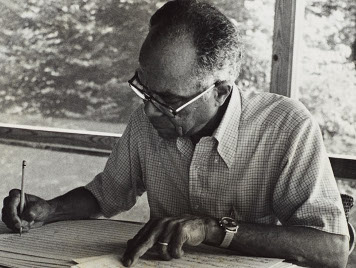Ulysses Kay (1917-1995) wrote more than one hundred forty compositions in a wide range of forms – five operas, over two dozen large orchestral works, more than fifty voice or choral compositions, over twenty chamber works, a ballet, and numerous other compositions for voice, solo instruments or dancer, film, and television.
As stated by Constance Tibbs Hobson and Deborra A. Richardson in Ulysses Kay: A Bio-Bibliography (1994): "Kay's contribution to America's cultural life and to its contemporary music scene is outstanding. His distinguished career, reflecting personal industry, discipline, and will, sets an encouraging, honorable, and inspiring example for all who follow. His message to aspiring composers strongly advocates continued study and growth in order to better express one's vision and individuality."
The Kay family gave the papers of Barbara and Ulysses Kay to Columbia in 2009, and they have since been cataloged. The finding aid for the collection is available through:
http://findingaids.cul.columbia.edu/ead//nnc-rb/ldpd_7341105
Exhibit Curator
Jennifer B. Lee
Biography and Kay Family »
Ulysses Kay was born in 1917, and attended the University of Arizona, followed by graduate work at the Eastman School of Music, Yale, and, after serving in the Navy in World War II, Columbia. He married Barbara Harrison in 1949 and the couple had three daughters. He was on the staff of Broadcast Music Inc. from 1952 until 1968 when he became a professor at Lehman College (CUNY), retiring in 1989. Kay died in 1995.
Barbara Kay »
During the 1960s, Barbara Kay was active in the Civil Rights Movement, participating in the Mississippi Freedom Rides, the New Jersey Englewood Movement, and the "March Against Fear."
Eastman and Yale »
At the Eastman School of Music, Kay studied with Bernard Rogers and Howard Hanson, followed by study with Paul Hindemith at Tanglewood and Yale.
U.S. Navy and Columbia »
During World War II, Kay served in the Navy Band stationed at Quonset Point, Rhode Island. At Columbia after the war, he studied with Otto Luening on a Ditson Fellowship, and spent his first of many summers in residence at Yaddo.
Prix de Rome and Other Honors »
Kay was the first African-American to receive the "Prix de Rome" from the American Academy of Arts and Letters. This allowed him to study and travel in Italy beginning in 1946, followed by another in 1949, when he was able to take Barbara with him. The American Academy elected him to membership in 1979. He received six honorary doctorates, and a host of other honors, including the Alumni Achievement Award from the Eastman School of Music.
Broadcast Music, Inc. »
Returning from Italy, Kay worked at Broadcast Music, Inc. from 1953 until 1968, first as an editorial advisor of concert music, and later as a consultant.
American Composers Alliance »
Kay was the featured composer in the Fall, 1957, issue of the American Composers Alliance Bulletin. It contained a major essay on his work to that date written by Nicolas Slonimsky.
State Department Mission to U.S.S.R »
In 1958, Kay was a member of the first delegation of composers sent to the Soviet Union, along with Roy Harris, Peter Mennin, and Roger Sessions. The following year, a group of six "musical ambassadors" from the U.S.S.R. came on a similar visit to the U.S.
Lehman College »
Kay became Professor of Music at Herbert H. Lehman College of the City University of New York in 1968, where he taught music theory and composition until his retirement in June, 1989.
Orchestral Music »
A selection of Kay's more than twenty five pieces written for orchestra. The works in each of the following sections are arranged chronologically by date of composition.
String Orchestra »
Kay was partial to the string orchestra, and in addition to pieces written for string orchestra alone, such as "Six Dances" and "String Triptych," he composed a number of works for solo instruments, solo voice, or choir and string orchestra, found in other sections below.
Band Music »
"Forever Free" is one of eight works that Kay wrote for concert band. His "Trigon," commissioned by the American Wind Symphony, was written for "wind orchestra," consisting of winds, brass, timpani, percussion, and harp.
Film and Television Scores »
Kay's work for film and television ranged from the documentaries "The Quiet One" and "City of Magic" to advertising work.
Ballet Music »
In addition to the two works described here, Kay wrote dance music into many of his compositions, such as his "Six Dances for String Orchestra."
Operas »
Kay's five operas, three one-acts, and two full three-act operas, are described here.
Solo Voice and Choral Music »
In addition to his operas, Kay wrote over fifty works for solo voice or choir in a variety of configurations.
Solo Instrument and Orchestra »
Kay wrote six works for solo instrument and orchestra or string orchestra.
Chamber Music »
Kay wrote two dozen chamber music compositions for a wide variety of instruments, including three string quartets, a woodwind quintet, a brass quartet, and works for chamber orchestra, in addition to the four works shown here.
Keyboard Music »
Trained first as a pianist, Kay wrote eight works for piano and two for organ, in addition to "Ancient Saga" for solo piano and string orchestra.
